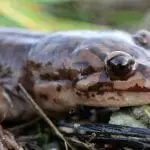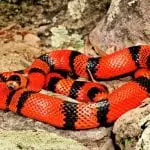Scientific Facts
| Common Name | Amazon Milk Frog, Panda Bear Tree Frog, Amazonian Milk Frog, Mission Golden-eyed Tree Frog |
| Scientific Name | Trachycephalus resinifictrix |
| Captive Lifespan | 5 – 10Years |
| Size | 2.5 – 4 inches |
| Mass | 4 – 5 grams |
| Habitat | Humid rainforest regions |
| Country of Origin | South America |
Physical Description
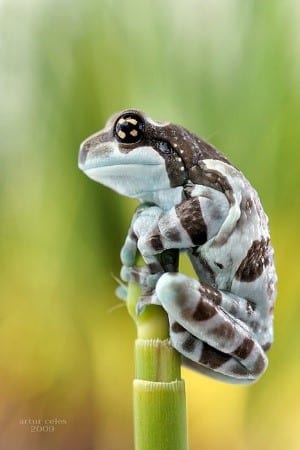
Amazon milk frogs are well-known for their attractive patterns and coloration. The distinct coloration and patterns are especially vivid with juvenile Amazon Milk Frogs, being banded in white and black, which is why these frogs are also referred to as panda bear tree frogs.
As Amazonian milk frogs mature, the contrasting, bright coloration changes. Black lightens up, turning into brown or dark gray. Meanwhile, the white coloration darkens, turning into shades of very light gray.
The texture of Amazon milk frogs’ skin is bumpy, granular, giving them a unique look. Female Amazon milk frogs are larger than males and can reach 4 inches, while males typically grow up to 2.5 inches.
With an overall rotund appearance, these large-bodied frogs have rather big, climbing-friendly hands that end with big toe-pads, catering perfectly to their arboreal lifestyle.
Types
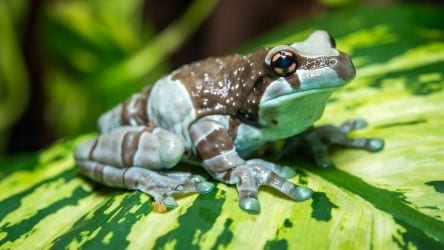
Trachycephalus resinifictrix is a unique species, with no subspecies. Other idiosyncratic frog species that occupy the tropical rainforests include the blue poison dart frog (Dendrobates tinctorius “azureus”), the red-eyed tree frog (Agalychnis callidryas), the golden poison frog (Phyllobates terribilis), and the tomato frog (Dyscophus antongilii).
Habitat & Lifespan
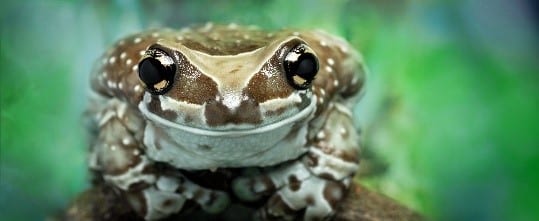
Amazonian milk frogs occupy rainforest regions where humidity is rather high. They can be frequently spotted in vegetation that extends over slow-moving water bodies.
Their natural range in the wild spans across Colombia, Venezuela, Brazil, British Guyana, Trinidad and Tobago, Ecuador, Bolivia, Peru, and French Guiana.
All throughout the Amazonian Basin, these stunning creatures can be found below 800m elevation.
Behavior

Amazon milk frogs usually rest during the day, in favor of being active at night, as these animals are nocturnal.
Until the night falls, Amazon milk frogs typically remain hidden inside the hollow cork bark tubes of the trees, or in other similar structures when it comes to Amazonian milk frogs kept as pets.
Although it is at night when these frogs become active in the wild, with the evening hours being the best time to admire these unique animals, captive Amazon Milk Frogs can be also observed during the day, shortly after their terrarium has been misted by the caregivers, as well as any time they are offered food.
Amazonian milk frogs have a reputation for being bold, and not nervous or wary around people, with whom they have gotten used to overtime. They can be easily handled as they mature. A particularly intriguing behavioral trait is their loud night call.
Housing
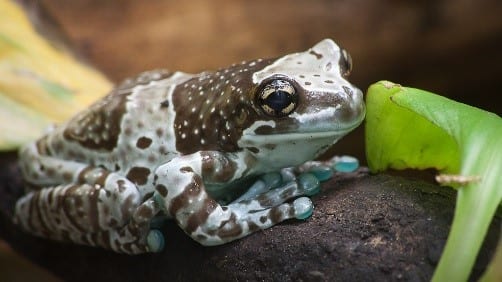
- For housing only a single one or no more than two adult Amazon milk frogs, a standard 20-gallon enclosure will work great.
- If up to five Amazonian milk frogs are to be housed together, then the enclosure needs to measure 24’’ in length x 18’’ in depth x 24’ in height.
- Juvenile Amazonian milk frogs should be placed in smaller containers than adults. A 10-gallon aquarium is ideal, as it will allow the caregiver to easily monitor the juveniles.
- Providing proper ventilation within the frogs’ enclosure is important to ensure their well-being. No fancy ventilation setups are required. A suitable screen cover will do a perfect job of offering reliable ventilation.
- In the wild, Amazon milk frogs will rarely (if ever at all) choose to come down on the ground, as these highly arboreal creatures prefer to spend most of their time in their unique homes high in the branches. This is the environment that caregivers should mimic when setting up the enclosure in order to allow for their milk frog pet to live up to its fullest potential.
- Perches, such as driftwood, bamboo poles, cork bark, and/or PVC pipe sections, should be utilized.
- Using live and/or artificial plants to enhance the enclosure’s aesthetic and functionality is also highly recommended. If live plants are desirable, it is best to opt for large-leafed, sturdy plant varieties, such as Neoregelia sp. Bromeliads and/orPhilodendron.
- Hiding areas are extremely important for these frogs’ well-being. Hiding spots should be reached to the top of the cage, and not merely rest on the floor, as to suit the arboreal nature of these animals.
- Several examples of suitable hiding spots arrangements include attaching the preferred type of hiding spots to the sides of the enclosure, using silicone sealant, and/or placing curved pieces of bark right against one of the sides of the aquarium.
- To mimic the natural environment of these frogs the best way, keepers are highly encouraged to make several suitably-sized holes in a piece of wood, and then place the piece on one side of the cage, so that the frog can use it as a hiding spot.
Substrate
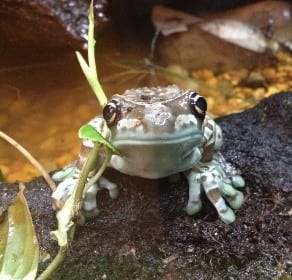
- Amazon milk frogs can thrive in the absence of a substrate. Doing so makes cleaning the aquarium’s bottom a fairly effortless task for the caregivers.
- If the substrate is to be utilized, caregivers should opt for one that is safe if swallowed by the reptile, capable of holding moisture, as well as easy to clean.
- If a substrate is desirable by the keepers, then sphagnum moss, foam rubber, or paper towels can be an excellent choice. Paper towels must be well-moist but not soaking wet.
- Coconut husk fiber can also make a wonderful substrate for these frogs.
- Another option is a safe soil substrate that has not been treated with any harmful chemicals.
- Do not opt for soils that contain perlite and/or vermiculite. Small bark chipping, gravel, as well as reptile cage carpet should also be avoided.
Temperature, Lighting & Humidity
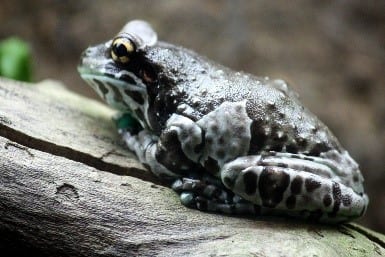
- On the warm side of the aquarium, temperatures should be kept between 80 – 85 degrees Fahrenheit during the day.
- On the cooler side of the enclosure, keep temperatures within the 70 – 75 degrees Fahrenheit range throughout the day.
- At night, temperatures within the enclosure can be allowed to drop down to 65 degrees Fahrenheit.
- If needed, incandescent light bulbs can be utilized for heating.
- Humidity levels should be kept within 50% and up to 100% range.
- Since these frogs thrive in high humidity, the enclosure should be misted daily for the purpose of ensuring temporary humidity increases. Reptile misters can do a wonderful job. For misting, caregivers should use reverse-osmosis water or dechlorinated tap water.
- Providing additional UVB lighting for captive Amazon Milk Frogs is a smart idea. UVB light bulbs of 2.0 and up to 5.0 strength will work great, as long as the bulbs are replaced annually, or based on the manufacturer’s instructions. Make sure to utilize appropriate light fixtures, and always position the UVB light bulb over a screen section of the enclosure’s cover.
- To make the enclosure look and feel more natural, keepers are also recommended to use a fluorescent light that comes in a more natural color spectrum, in particular, 5000 – 6500K.
Diet
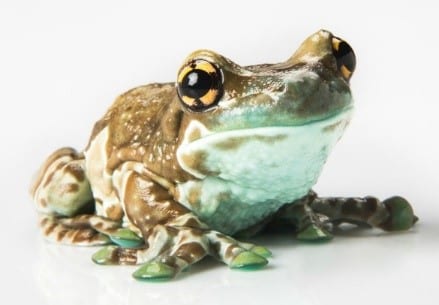
Amazon milk frogs should be provided a variety of live invertebrates, as nutritional, varied food is key to keeping these frogs in optimum health.
It is highly recommended that crickets make up for the largest portion of the captive Amazonian milk frogs’ diet. However, other live foods, such as cockroaches, earthworms, and house flies, must not be underestimated, as these should be rotated on a regular basis.
Young milk frogs can be fed with flightless fruit flies, with food being offered daily for the juveniles.
Adult Amazon Milk Frogs should be fed only 2-3 times per week. Each mature frog should receive 3 – 10 food items per feeding.
Vitamin A and Vitamin D3 supplementation are crucial for a healthy, varied diet for captive milk frogs.
Eating Habits
One of the most pleasurable aspects of having an Amazon Milk Frog pet is certainly feeding time.
The eating habits of these creatures can be best described as rarely fussy. These food-greedy animals are gluttonous, and nonetheless, adorable to watch during their feeding routine.
Despite being nocturnal creatures, Amazonian milk frogs kept in captivity quickly learn to wake up during any time of the day when food is to be provided at their disposal.
Sleeping Habits
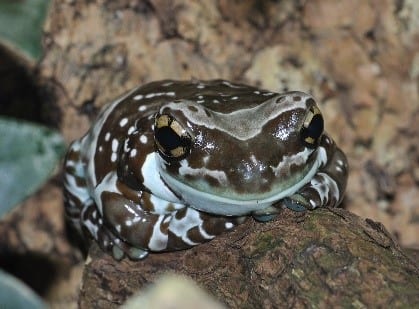
Amazon milk frogs are known to become active at night unless food is offered during the day and/or their enclosure is carefully misted. These frogs do not hibernate.
Water
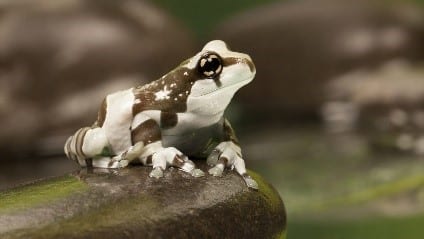
In the wild, Amazon milk frogs spend quite much of their time up in the branches. However, this does not mean that these creatures don’t require a constant source of freshwater since the large tree holes they inhabit in their natural range are actually filled with water!
For captive Amazon milk frogs, filling the holes of suitable pieces of wood used as hiding spots is not the best idea. Placing a large water dish will serve great, though.
Amazon milk frogs’ water should be changed every day. Do NOT use plain tap water. Water must be dechlorinated (free of both chloramines and chlorines).
Development and Reproduction
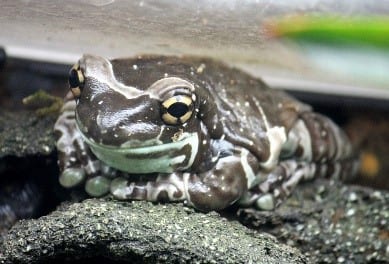
In the wild, Amazon milk frogs are known to breed in upward-facing, water-filled tree holes.
It is from the tree holes where male Amazonian milk frogs call with the purpose of attracting females. If a female arrives, the couple is to engage in a mating position, aka amplexus, with the male clasping the female’s back.
Interestingly, the females lay the eggs right on the surface of the water in the tree holes.
Tadpoles will gladly feed on just about anything feasible, although the largest portion of their natural diet consists of the eggs of their very own species.
Some other types of frogs feed infertile eggs straight to the tadpoles; however, this is not the case with Amazon milk frogs. Female milk frogs do another “trick” instead. They frequently breed in the very same tree hole repeatedly, which results in the tadpoles availably eating the newly laid eggs.
How to Breed
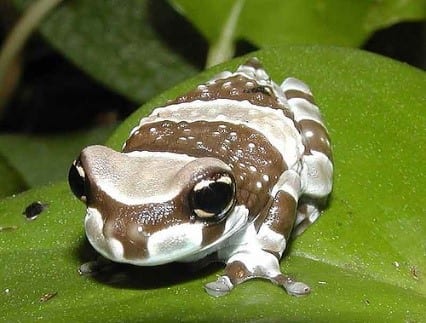
- Amazon milk frogs can be successfully bred in captivity, as long as the pair is in perfect overall health and has been well-fed prior to mating. Also, suitable water-filled areas for the purpose of eggs deposition are required.
- Some breeders choose to cycle the frogs prior to breeding by subjecting the amphibians to a “rainy season” within a specifically designed rain chamber; however, many breeders have successfully bred their captive Amazon milk frogs without any previous cycling-related with altering humidity and temperature using a special rain chamber.
- First and foremost, Amazon milk frog breeders-to-be need to realize that triumphant breeding will result in hundreds of new, tiny frogs. Because of this, breeders must be seriously prepared for housing and taking proper care of the resulting froglets, or else, the breeding attempt will actually turn into a complete, senseless failure. No matter how tiny, the baby Amazon milk frogs require a lot of care, so make sure you are well-prepared prior to any breeding attempts.
- You can tell male milk frogs from females by their size. Males are generally and visibly smaller. They rarely ever exceed 2 ½ inches.
- Adult female Amazon milk frogs typically grow up to 4 inches, and they are visibly bigger and fatter than the males.
- Another way to tell males from females is that males call. If your milk frog shows vocalization, then you are dealing with a male.
- Amazonian milk frogs reach sexual maturity once they turn 1 and ½ years of age (18 months).
- For higher likeliness of breeding success, it is best to go for a large group of milk frogs, for instance, at least 5 or even 10, instead of only going with a single pair. Having more males in the group is essential, as it promotes breeding, so make sure to have fewer females in favor of more males, if possible.
- Your goal as a milk frog breeder is to replicate the tree holes where these amazing creatures are known to breed. For this purpose, something as simple as a large water dish can resemble a tree hole fairly well enough.
- Although milk frogs are highly likely to lay their eggs in a simple water dish, you can increase your chances of successful breeding if you go the extra mile. Consider attaching the water dish onto a suitably-sized, big cork bark tube. Wedge the cork straight into the tube (make sure the size of the water dish fits the size of the bark tube). Once into place, the water dish should be able to stand vertically without any extra support, all on its own.
- By opting for attaching a water dish onto a big cork bark tube, breeders can recreate (almost) perfectly a water-filled tree hole.
- There is another option to recreating the naturally water-filled tree holes needed for breeding your Amazon milk frogs. You can use a plastic box to construct a tree hole, with a hole that is large enough, based on these amphibians’ size, to allow the frogs to enter and exit. The bottom of the box should be filled with only a couple of inches of water.
- Apart from the tree holes-resembling options listed above, some breeders prefer to simply fill the entire enclosure’s bottom with water (about several inches), and so they never really get to use a water dish. However, with this particular approach, having plenty of objects that will allow the frogs to protrude the water surface and exit safely and easily is crucial. Suitable objects include driftwood, tubes, and/or cork bark flats.
- By opting for filling the entire bottom of the enclosure with water and placing lots of suitable objects for breeding your milk frogs, you essentially turn the enclosure into a huge tree hole; at least this is how the frogs will perceive it.
- Regardless of which approach you choose to apply when it comes to creating an artificial tree hole, it is a must to change the water regularly. Changing the water daily will work best, if possible.
- If a suitable breeding site is available, a group of well-fed, healthy Amazon milk frogs is to breed without any further interference. In the case, females appear to be particularly plump, yet no eggs are deposited, you can alternatively try to move the females into a rain chamber.
- The clutch size can be anything from 100 to over 1500 eggs. As soon as eggs are noticed by the breeder, the entire plastic box, water dish, or any other tree hole-like arrangement must be removed from the enclosure. Then, the eggs should be placed in a separate enclosure, or else, they can be disturbed by the mature milk frogs.
- Expect to see tadpoles breaking free from the eggs within only two days!
- As soon as the eggs hatch, move the tadpoles into suitable aquariums, carefully prepared in advance.
- As tadpoles begin to mature, they will inevitably start to produce more waste. Because of this, it is best to divide tadpoles into several aquariums, although this may not be needed in the case the clutch of eggs is only small in size, resulting in fewer tadpoles than large clutches.
- In the wild, Amazon milk frog tadpoles have been reported to develop at densities that can reach as high as 60 tadpoles/ 1 gallon of water. If you have enough free room, though, it is highly recommended to raise them in lower densities to increase chances of survival, as well as to be able to take better care of these extraordinary creatures.
- Feed tadpoles with groundfish flake once every day, as soon as you notice that they become active, moving around the enclosure.
- Unlike other frog species, Amazon milk frog tadpoles do not require to be fed with the eggs of their own species. However, it is important to make sure to avoid overfeeding. You will know that you are overfeeding if all of the food has not been fully taken only a couple of hours shortly after feeding.
- To maintain water quality, use sponge filters. Also, change about 20% – 30% of the water 2-3 times weekly.If tadpoles are not densely stocked, and if water changes are executed more frequently (about 5 times per week), then breeders can skip on using filtration altogether.
- Maintain water temperatures within the 74 – 78 degrees Fahrenheit range. Doing so will result in tadpoles completing metamorphosis in about 38 – 75 days.
- In the case you need to raise the water temperatures, submersible aquarium heaters can do a great job. Always utilize a reliable thermometer to monitor water temperatures, and adjust immediately if needed.
- At some point, tadpoles will develop front arms. As soon as the breeder is to notice these new formations, tadpoles must be moved to a separate container, where water is less than 1 inch deep. Dead leaves and/or other similar objects sticking out of the water must also be provided.
- When about ½ inch long, the tail of Amazonian milk frogs’ tadpoles will be absorbed. The tiny milk frogs will then be able to climb out of the water. This is the time when the keeper needs to move the froglets into a terrarium.
- Amazon milk froglets’ terrarium only requires a fairly simplistic setup, consisting of moist paper towels, some artificial or live plants, as well as a water dish. Their health and proper development can be easily monitored with this kind of setup.
- Caregivers can house 20 or more Amazon milk froglets in a common 5-gallon aquarium. However, as they keep growing, it is a must to move them into new, additional enclosures. By reducing their density, you will prevent small frogs from falling victims to severe food completion. With this in mind, when sorting the frogs into new enclosures, do so based on their size.
- Feed the small frogs with small crickets and flightless fruit flies every day, and do so at least once daily. Cover the food with vitamin and mineral supplements.
- Young frogs should be provided with proper UVB light radiation. For this purpose, 2.0 and up to 5.0-strength light bulbs will do great.
- Maintain temperatures within the 75 – 85 degrees Fahrenheit range. Young Amazonian milk frogs grow rather quickly.
Handling

It is not recommendable to handle an Amazon milk frog, and especially when it comes to juveniles, handling should be strictly avoided. However, adult milk frogs are known to tolerate handling well, as long as this is only done occasionally.
Handling these incredible amphibians is not recommended because of the fact that their skin is permeable and rather sensitive. Humans will not suffer great harm from handling an Amazonian milk frog, but the frogs may end up in big trouble because of the naturally occurring salts and oils found on human skin.
Whenever handling is needed, for instance, when examining the health of your milk frog pet, or when it comes to enclosing cleaning services, it is best to use disposable gloves. Make sure these are powder-free. Gently take the frog by placing your hand below the belly zone and lift it without squeezing it too tightly.
How to Treat and Prevent Possible Health Issues
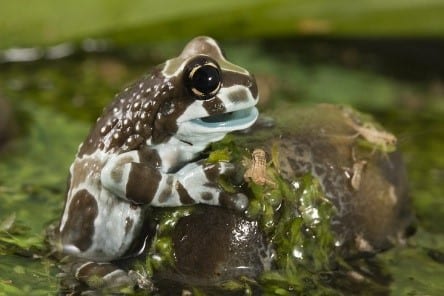
- As long as one is to obtain a captive-bred Amazon milk frog from reputable breeders or retailers, and as long as the keeper is to follow strictly the care instructions for these amazing amphibians, milk frogs are known to be sturdy and thrive in perfect health for years to come, with only basic, yet regular maintenance involved.
- It is always best to have your Amazon milk frog examined by a qualified vet annually.
- Using high-quality mineral and vitamin supplements is crucial to protect your milk frog from unwanted nutritional problems. Opt for a supplement that contains Vitamin D3 and Vitamin A, and is free of phosphorus. For juveniles, cover food with the supplement at every single feeding. For adult milk frogs, cover food with the supplement only every other feeding.
- Only provide reverse-osmosis or dechlorinated water to protect your milk frog from harm, since these creatures are vulnerable to chlorines.
- Fungi and bacteria are the worst enemies to the health and well-being of captive Amazonian milk frogs. The entire enclosure must be spot cleaned every two weeks. Using soaps or detergents when cleaning is not recommended. Instead, hot water should be utilized to energetically and carefully scrub the entire enclosure, including any equipment and decorations.
Possible Dangers to Humans

It is imperative to wash your hands thoroughly with hot, soapy water every time after handling a milk frog, as well as after touching any of the equipment and decorations within the enclosure after cleaning services.
Also, never touch your mouth, eyes, or nostrils after handling an Amazon milk frog, as this can lead to quite unpleasant sensations, and/or further possible irritations that may require immediate consultation with a qualified physician because of the mild toxin released through this amphibian’s skin.
Availability: How to Get an Amazon Milk Frog?
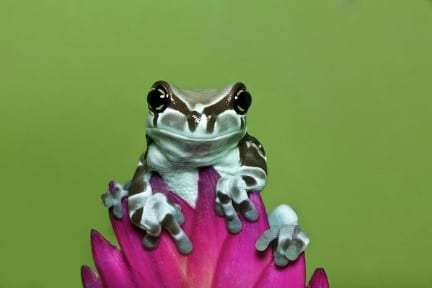
Back in time, locating captive-bred Amazon milk frogs used to be a fairly difficult task. However, nowadays, things have drastically changed, thanks to captive breeding programs that keep being successfully accomplished.Because of the captive breeding progress, Amazon milk frogs are now part of many collections worldwide.
One can get an Amazonian milk frog from some local reptile shops and shows, as well as online.
It is best to avoid purchasing freshly metamorphosed frogs, regardless of how tempting this might be as one gets to take a look at a tiny, cute, impressively colorful froglet. Small froglets are significantly trickier to maintain properly, as they are much more sensitive than juveniles that have already reached a relatively large size.
Caregivers, especially the newbies, are highly recommended to buy an Amazon milk frog that is at least 1 inch in length.
A healthy Amazon milk frog is to be asleep during the day, with the exception of possibly emerging from the perches only if it has been fed just recently.
Look for a frog that appears rotund rather than slender. Healthy Amazonian milk frogs will be heavyset and somewhat fat. Slender ones are sure to have not been taken proper care of and/or to be suffering from various possible health issues.
Fun Facts
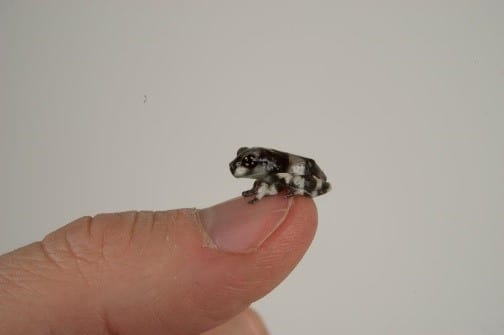
- Living up true to their name, Amazon milk frogs are known to release milky white secretions whenever they are to feel threatened. These secretions are released from the back. Even though this secretion is toxic to many of the Amazonian milk frog’s predators in the wild, it does not pose a serious threat to humans.
- Captive-bred Amazon milk frogs do actually rarely ever release the notorious milky, whitish secretions. As captive animals are getting used to people from an early age, they do not feel threatened as to release the secretions, unless under particular conditions, including but not limited to improper, prolonged handling.
- Apart from being called the Amazon Cave Frogs because of inhabiting the unique “caves” in tree holes, Amazon milk frogs are also known as Gold Mission Frogs, because of the crucifixes-like black markings on their eyes.
- The special toe-pads on Amazon Milk Frogs’ feet are perfectly suited to these creatures’ arboreal lifestyle. Thanks to these toe-pads, milk frogs can climb plants confidently, especially since the toe-pads are capable of holding up to 14 times the amphibian’s total body weight.
How to Take Care of an Amazon Milk Frog
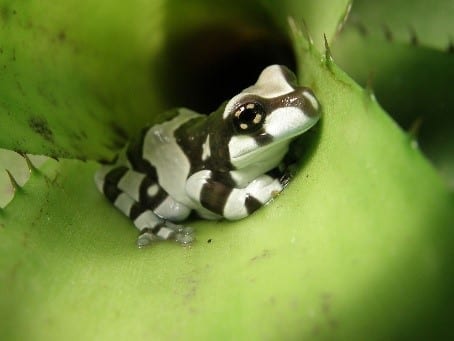
- Mind that mature Amazon milk frogs are not small frogs, and as such, they are fully capable of making a big mess. With this in mind, the enclosure should be set up carefully, with every piece of equipment being well-secured as to limit possible fuss related to frequent cleaning and maintenance servicing.
- It is a must that water bowls are to be cleaned every day. Keepers need to clean the water bowls thoroughly by scrubbing the bowls with hot water.
- If the substrate is utilized, it has to be changed at least once every week. For keepers using paper towels as substrate, make sure to clean daily.
- Apart from using hot water (no detergents or soaps involved!) to spot clean the enclosure and décor on a weekly basis, keepers are highly recommended to use a 5% bleach solution.
- Young Amazonian milk frogs are very tender and fragile. Do not handle them regularly, or you can easily cause irreversible harm.
- Wait until your milk frog pet has reached at least 2’’ (or better yet, larger), before you start handling it more frequently but then again, not regularly.
- Before handling an Amazon Milk Frog, make sure to moisten your hands with clean, dechlorinated, or reversed-osmosis water.
- Always wash your hands thoroughly with soapy, warm water every time after handling your milk frog.
- Before acquiring an Amazon milk frog, your smartest move is to set up the enclosure at least 7 days in advance. Doing so will allow the caregiver to carefully monitor the conditions inside, and to adjust temperature/humidity/lighting if needed, prior to introducing the frog inside.
- It is a must to use an accurate thermometer and hygrometer devices to measure and maintain the temperature and humidity levels inside the enclosure precisely at all times.
FAQs
Are Amazon Milk Frogs Poisonous?
The milky-white secretions excreted by Amazon milk frogs are used as natural protection against possible animals. However, these secretions are not poisonous to humans, causing no significant harm when these amphibians are handled (captive-bred milk frogs do rarely ever excrete these secretions at all). However, it is a must to always wash hands thoroughly after handling an Amazon milk frog, without touching your mouth, eyes, or nostrils prior to washing your hands, as the secretion can cause temporary irritation and burning sensation.
How Long Do Captive Amazon Milk Frogs Live?
Captive Amazon milk frogs live for about 8 years on average. However, with proper care, they can easily live for more than 10 years.
How Do You Take Care of an Amazon Milk Frog?
Several conditions will greatly contribute to taking care of a happy, healthy, long-lived captive Amazon milk frog. These include providing a varied diet, as well as high-quality Vitamin D3 and Vitamin A supplement with every other feeding for adult milk frogs. Also, it is the caregiver’s responsibility to maintain high hygiene and proper temperature, humidity, and lighting within the enclosure.
What to Feed Amazon Milk Frogs with?
It is best to feed captive Amazon Milk Frogs with appropriately sized crickets as the primary source of essential nutrients. Other insects to include an Amazon Milk Frog’s diet, making up for about 30% of the staple diet of the amphibian, including roaches, wax worms, mealworms, and hornworms. Milk frogs have the reputation of voracious eaters, so treating them with a pinky mouse occasionally will be much appreciated.
Do Amazon Milk Frogs Produce Milk?
No, Amazon milk frogs do not produce milk, as in the animal kingdom, it is only mammals to produce milk for their young. Amazon milk frogs produce milky-white secretions in order to keep possible predators at bay, as these secretions emit a faulty smell, and are toxic to intruders if swallowed. However, these secretions have nothing to do with milk in the traditional sense of the word.
Do Amazon Milk Frogs Make Good Pets?
With their unique arboreal lifestyle, charming appearance, and enjoyable temperament, Amazon milk frogs can make good pets for the right owners. Amazon milk frogs are relatively low-maintenance, they have a great appetite without being pretentious, and are generally easy to take care of, as long as dedication and strictness about their care requirements are applied by the keepers.
Do Amazon Milk Frogs Need Lighting?
A heat lamp is helpful for keeping the temperature within the Amazon milk frog’s enclosure within the desired range. Although milk frogs are nocturnal creatures and do not require plenty of sunlight to thrive in the wild, captive Amazon milk frogs do need suitable lighting for the purpose of mimicking the day and night cycle typical for their natural habitat.
Do Amazon Milk Frogs Bite?
Amazon milk frogs do not bite, even if they are to feel threatened. In fact, biting almost never occurs with most frog species. One of the only very few frogs that are known to defend themselves by providing a series of nasty bites with their sharp teeth is Pacman frogs.
Do Amazon Milk Frogs Sleep?
Since Amazon milk frogs are nocturnal creatures, it is easy to assume that they spend the day sleeping. And even though Amazon milk frogs are not typically active during the day, it is not fully accurate to claim that they are sleeping. There is still very little research, and no clear evidence regarding sleep patterns in frogs, especially with brain scans failing to confirm whether frogs really get to have a sleep period, even when their eyes are closed.
Do Amazon Milk Frogs Need UVB?
UVB light is an important factor for ensuring the health and well-being of various captive amphibians, Amazon Milk Frogs included. Some keepers take advantage of natural sunlight to ensure their milk frog’s UVB requirements are satisfied, and/or opt for additional UVB light bulbs as necessary.
Can You Cohabitate Multiple Amazon Milk Frogs?
Yes, Amazon Milk Frogs can be successfully and relatively easily cohabitated. Amazonian milk frogs are known to coexist peacefully when in groups, even though sometimes it is possible for males to only occasionally harass females in the group.

